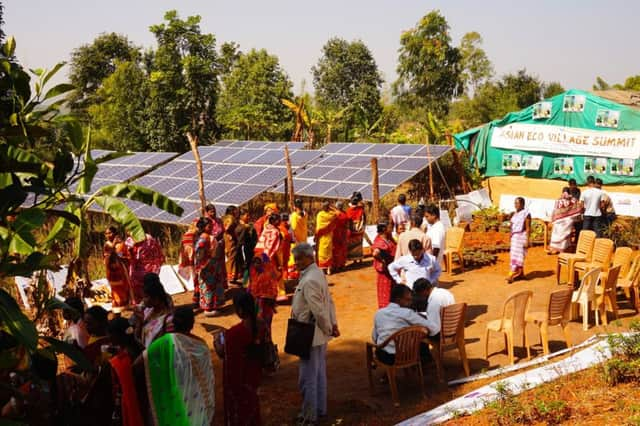May East: Women tackle the root causes of poverty – with a dash of turmeric


Local food production systems typically contain a multiplicity of local economies and hundreds of small enterprises, addressing the social and economic fragility of rural areas and the urban need for good food.
Sitting in her office in Singapore, a young commodities futures exchange trader tells me the annual sugar budget of one country can be negotiated in three weeks. I ask her how much traders like her understand about the working conditions of those involved with the sugar cane plantations. The answer was obvious… very little.
Advertisement
Hide AdAdvertisement
Hide AdBut change is on the horizon thanks to technology which is not only strengthening the commitment to local food systems, but also promises real time traceability as a means of ensuring transparency at every level of the food production chain.


We are witnessing a growing recognition of the importance of supporting local producers. More and more of us are concerned about the provenance of our food. Increasingly, we want to know how it was produced, where and by whom. Now, through ‘blockchain’, each actor in the supply chain and each part of the food distribution process can be transparently recorded. Blockchain promises a world where consumers can verify the exact provenance of their food and how much the person who cultivated the produce was paid.
Furthermore, it can address the tensions that prevent a multitude of sustainability, humanitarian, and environmental initiatives from fulfilling their potential while accelerating our collective progress towards meeting the UN Sustainable Development Goals (SDGs).
In the Indian state of Orissa, the annual monsoon is considered its de-facto ‘Minister of Agriculture’ with a direct – and sometimes catastrophic – influence on the course of farming. Recently erratic, late or insufficient monsoons, cyclones and coastal erosion have had a direct impact on the productivity of the non-irrigated rainfed agriculture cultivated by the tribal villagers, in particular women.
Koraput District is particularly vulnerable. Deforestation has led to the loss of indigenous crops, replaced by genetically modified crops which are then sold in the international commodities market. As a result, women have been forced to farm smaller plots and traditional varieties of millets, yam and tuber crops are gradually disappearing. Age-long resilient indigenous lifestyles and cultural values are being eroded in the process.
For the last 10 years, the women’s federation Orissa Nari Samaj, in partnership with the Indian NGO THREAD and Gaia Education, has been developing locally adapted agro-ecological responses, while attempting to address the deeper structural changes needed to tackle the root causes of poverty and climate change in the region. As a result of these activities, women were able to develop their kitchen gardens and earn supplemental incomes through surplus produce, thus creating an upward food security spiral and longer-term social-ecological resilience.
Climate-resilient agricultural approaches are continually being developed, such as drought resilient crops incorporated with mulching, fortified composting, vermiculture and vermicomposting, herbal pesticides, seed preservation and green manure. At the heart of our activities is a Grow Your Own Food campaign, designed to counteract Climate Smart Agriculture (CSA) techniques, which encourage the use of GM seeds, chemical pesticides and synthetic fertilisers.
With the soil enriched through agro-ecological practices, the women of Koraput are now cultivating high quality organic turmeric in their kitchen gardens. From cultivation, harvesting and powdering, each step of the process has been carefully developed by the women themselves. In its powder form, turmeric contains numerous medicinal properties. With powerful bioactive anti-inflammatory compounds, it’s claimed that turmeric powder increases antioxidant capacity in the body that can lower the risk of heart disease and improve brain function. It is also said to be beneficial for preventing cancer. When added to food, it provides colour and flavour, bringing the taste of India to dishes.
Advertisement
Hide AdAdvertisement
Hide AdUnder the SDG framework, turmeric from Orissa is now being sold to ethical buyers in the UK. Those involved in the supply chain are investigating the process of establishing a blockchain-based tracking system which could include social audits to ensure compliance with SDGs, in particular SDG1 (no poverty), SDG5 (gender equality) and SDG13 (climate action).
SDGs are expected to create at least $12 trillion in new market opportunities by 2030. The goals intend to bring millions of people previously reliant on public aid into the global economy. But what sort of economy?
Business cannot succeed in ecologies and societies that fail. To achieve a resilient future, we need to revisit the conventional food system and its reliance on large-scale agro-food enterprises operating at global level. We need to challenge the transfer of the most productive land from food production for local needs to export for consumption by the global consumer class.
Commodity traders need to set aside narrow short term gains and align new revenue opportunities with a socially conscious approach that makes both people and the rest of the natural world stronger, more vibrant and resilient.
May East, CEO Gaia Education.